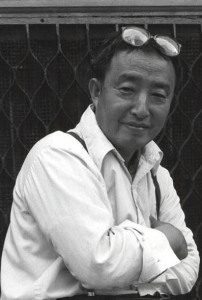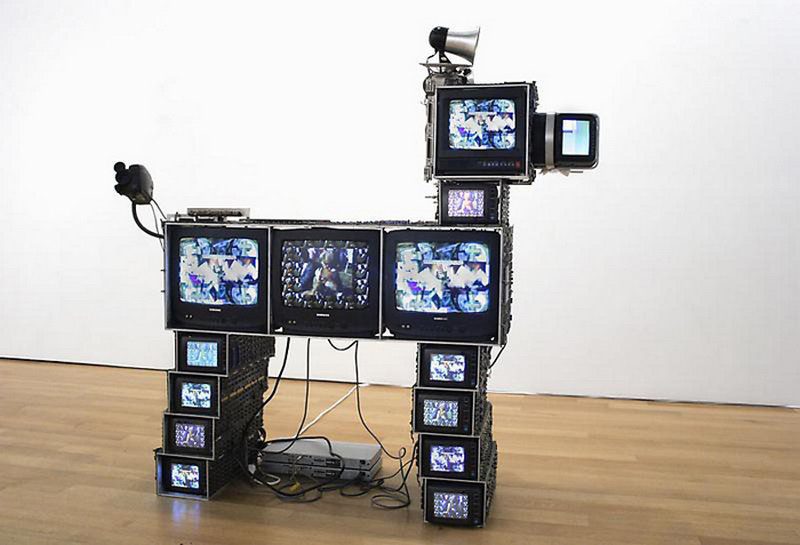TRACES: Nam June Paik
 Today is the occasion to bear in mind the South-Korean artist Nam June Paik (20/7/1932-29/1/2006), who is commonly hailed as the “father” of new media art for his discoveries in music, video, performance, television broadcast and technological experimentation. He balanced a Utopian philosophy with a technical pragmatism and a subversive sense of humor, creating works that drew on chance encounters between ideas, the object and the public. This column is a tribute to artists, living or dead, who have left their mark in Contemporary Art. Through documents or interviews, starting with: moments and memories, we reveal out from the past-unknown sides of big personalities, who left their indelible traces in time and history…
Today is the occasion to bear in mind the South-Korean artist Nam June Paik (20/7/1932-29/1/2006), who is commonly hailed as the “father” of new media art for his discoveries in music, video, performance, television broadcast and technological experimentation. He balanced a Utopian philosophy with a technical pragmatism and a subversive sense of humor, creating works that drew on chance encounters between ideas, the object and the public. This column is a tribute to artists, living or dead, who have left their mark in Contemporary Art. Through documents or interviews, starting with: moments and memories, we reveal out from the past-unknown sides of big personalities, who left their indelible traces in time and history…
By Dimitris Lempesis
 Born in Seoul in 20/7/32, as he was growing up, he was trained as a classical pianist. In 1950, during the Korean War, Paik and his family moved at first in Hong Kong and later in Japan, when he graduated from the University of Tokyo. Paik then moved to West Germany to study music history with composer Thrasybulos Georgiades at Munich University. While studying in Germany, Paik met the composers Karlheinz Stockhausen and John Cage and the conceptual artists George Maciunas, Joseph Beuys and Wolf Vostell and was from 1962, a member of Fluxus. Ηe used of everyday sounds and noises in his music. He made his big debut at the exhibition “Exposition of Music-Electronic Television”, in which he scattered televisions everywhere and used magnets to alter or distort their images. In 1964, Paik moved to New York, and began working with classical cellist Charlotte Moorman, to combine his video, music, and performance. In the work “TV Cello”, the pair stacked televisions on top of one another, so that they formed the shape of an actual cello. In the 1970s, Paik imagined a global community of viewers for what he called a Video Common Market which would disseminate videos freely. In his 1974 proposal “Media Planning for the Postindustrial Society – The 2st Century is now only 26 years away” to the Rockefeller Foundation, he wrote: “The building of new electronic super highways will become an even huger enterprise. Assuming we connect New York with Los Angeles by means of an electronic telecommunication network that operates in strong transmission ranges, as well as with continental satellites, wave guides, bundled coaxial cable, and later also via laser beam fiber optics, the expenditure would be about the same as for a Moon landing, except that the benefits in term of by-products would be greater”. His idea of the Electronic Super highway envisioned the Internet; 40 years later, it is easy to acknowledge its transformational power to turn the wide world into a global village. During the New Year’s Day celebration on January 1, 1984, he aired “Good Morning, Mr. Orwell”, now often regarded as the first international satellite installation, a live link between New York, Paris, and South Korea. With the participation of John Cage, Salvador Dalí, Laurie Anderson, Joseph Beuys, Merce Cunningham, Allen Ginsberg and other artists, Paik showed that George Orwell’s Big Brother had not arrived. In 1986, Paik created the work “Bye Bye Kipling”, a tape that mixed live events from Seoul, Tokyo and New York. For the Seoul Olympic Games, he created “The more the better”, a giant tower made entirely of 1003 monitors.
Born in Seoul in 20/7/32, as he was growing up, he was trained as a classical pianist. In 1950, during the Korean War, Paik and his family moved at first in Hong Kong and later in Japan, when he graduated from the University of Tokyo. Paik then moved to West Germany to study music history with composer Thrasybulos Georgiades at Munich University. While studying in Germany, Paik met the composers Karlheinz Stockhausen and John Cage and the conceptual artists George Maciunas, Joseph Beuys and Wolf Vostell and was from 1962, a member of Fluxus. Ηe used of everyday sounds and noises in his music. He made his big debut at the exhibition “Exposition of Music-Electronic Television”, in which he scattered televisions everywhere and used magnets to alter or distort their images. In 1964, Paik moved to New York, and began working with classical cellist Charlotte Moorman, to combine his video, music, and performance. In the work “TV Cello”, the pair stacked televisions on top of one another, so that they formed the shape of an actual cello. In the 1970s, Paik imagined a global community of viewers for what he called a Video Common Market which would disseminate videos freely. In his 1974 proposal “Media Planning for the Postindustrial Society – The 2st Century is now only 26 years away” to the Rockefeller Foundation, he wrote: “The building of new electronic super highways will become an even huger enterprise. Assuming we connect New York with Los Angeles by means of an electronic telecommunication network that operates in strong transmission ranges, as well as with continental satellites, wave guides, bundled coaxial cable, and later also via laser beam fiber optics, the expenditure would be about the same as for a Moon landing, except that the benefits in term of by-products would be greater”. His idea of the Electronic Super highway envisioned the Internet; 40 years later, it is easy to acknowledge its transformational power to turn the wide world into a global village. During the New Year’s Day celebration on January 1, 1984, he aired “Good Morning, Mr. Orwell”, now often regarded as the first international satellite installation, a live link between New York, Paris, and South Korea. With the participation of John Cage, Salvador Dalí, Laurie Anderson, Joseph Beuys, Merce Cunningham, Allen Ginsberg and other artists, Paik showed that George Orwell’s Big Brother had not arrived. In 1986, Paik created the work “Bye Bye Kipling”, a tape that mixed live events from Seoul, Tokyo and New York. For the Seoul Olympic Games, he created “The more the better”, a giant tower made entirely of 1003 monitors.














